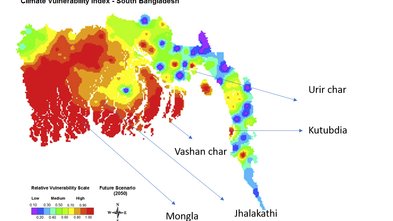
Upscaling the concept of "floating homes"
properties.trackTitle
properties.trackSubtitle
The Dundee University and Resilience Solution, the research implementation partner from Bangladesh, have won the 2019 RISK Award. Their intention is to further develop a unique "Disaster Resilient Floating Homes” concept on the coast of Bangladesh. The homes will withstand natural catastrophes and other effects of climate change thus serving the resilience of their inhabitants. The houses are also able to provide new and sustainable livelihood options.

Three family-run demonstration houses were built on the flood-prone areas of Shariatpur district in 2018. The local population was involved in the design and construction which drew also on ideas forwarded by the local community. The actual construction of the houses was greeted with enthusiasm: the houses created jobs, gained a lot of attention which lead to a corresponding high number of visitors. Coffee shops and kiosks in the neighbourhood benefited. However, social conflicts became evident after the completion: families selected to live in the houses had problems being accepted by larger parts of the community. Political power relationships and practical constraints even forced some families to abandon the houses. Also, responsibilities for the maintenance of the houses were not properly defined. Hence, within the pilot phase the ownership couldn’t be properly transferred. These socio-political pitfalls have to be avoided in the now upcoming RISK Award project.

Because of the range of approaches possible, five villages in Bangladesh were selected prior to the actual commencement of the project. The starting point is in-depth participative discussions with all different groups within the population, village representatives and relevant institutions. The next step will not be taken until it becomes clear that there is a lasting interest in the project and a good chance for sustainable success. The village with the most promising enabling environment for project implementation will be chosen after this initial phase.

As well as the careful selection of the site of the next project, a further important point is the definition of the most suitable design for the house. The individual, family-run houses of the pilot phase proved not to be the best solution. They interfered too much with the complex local social system, resulting in exclusion, envy, and distrust. The project team is actually discussing alternative options. For instance, a floating school could solve many of the existing social problems and create win-win situations. Pupils can learn how to deal with climate change, how alternative methods of farming can generate income, and how renewable forms of energy can be used – even in the housing context. The school can become partially self-financing through the income generated from the building itself. As all the children of the village would benefit, envy and distrust would be significantly reduced. The floating home could also be offered to a rural development partner working in the village. They could use it as an institutional home, for educational programmes related to the floating homes concept, and even could think of shelter-options during disasters.
The overall objective is to increase the awareness and popularity of the concept. This means a paradigm shift in "where" and "how" people can live along the coasts of Bangladesh. This change can only be achieved if people really are intrinsically convinced. And changes in social behaviour normally take a certain time. In many locations of the country a race against time as a result of external stressors caused by disasters and climate change has started. The innovative floating homes can be a game changer – not only in Bangladesh.
27 August 2019